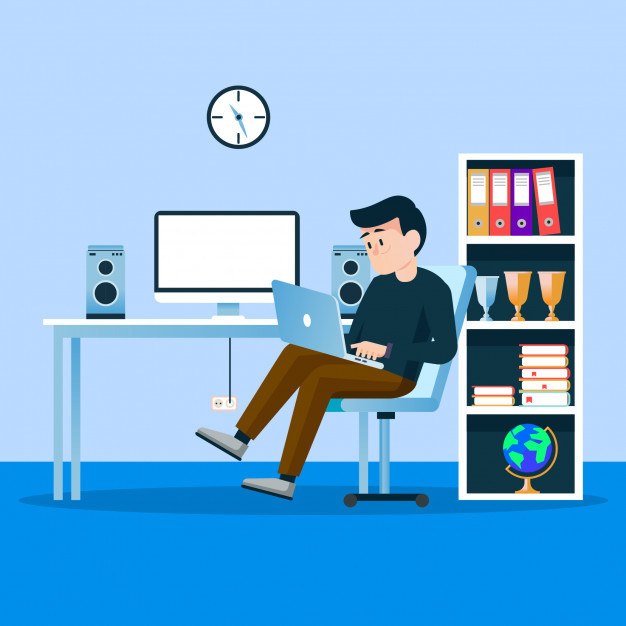Are We Corona Captives Turning to Screen Slaves? How to Have a Healthy Proportion of Screen Time During Our Home Learning Period

By Irma Windy Astuti, S.S., M.Hum.
In time of Covid-19 crisis, it feels like the world has been drastically twisted and turned. Even though the world has not been completely turned-off, a lot of things suddenly require immense changes and adjustment to ensure our safety. The Work from Home and Social Distancing policies have affected the usual businesses we do. The offices, schools and universities are just some of the areas affected by the pandemic. For us in the education arenas, the circumstance has given teachers and lecturers very few options but to fully embrace online/ distance learning. As a result of it, educators quickly brace themselves in taking up and getting themselves acquainted with the challenges of online learning. Most of us (teachers) have endured this one month of self-quarantine juggling to meet the need of the students and to best comply to the courses’ learning objectives. A lot of discussions about online learning techniques and its tips & tricks have also been shared and implemented by many educators, including how to adjust the learning materials and ease the teaching delivery in order not to overwhelm the students.
From time to time though, the discussions on online learning have not only been about the course content, subject matter, methods and/ or their technicalities. Teachers and parents are also starting to get concerned about the well-being of their students and children (both for physical and psychological reasons). While the internet and the online technologies have done wonders in facilitating our distant work and learning, several side problems have also begun to emerge. Ever since the majority of the world went fully online for working and studying, most of us have had a significant increase of screen time. Screen time is the amount of time we spend staring at various screens (of our laptops, mobile phones and televisions) for various work/ study-related and entertainment purposes. Our laptops and cell phone have indeed become major parts of our lives and their screens are our windows to the many worlds. However, our heavy physical reliance on them is not without some lurking health risks. Too much screen time is obviously not good for our overall health, especially for our eyesight.
Even long before the covid outbreak and the burst of online learning, a lot of people (parents, especially with young children, health professionals and educators) have already taken the excessive use of screen time seriously, including none other than, the World Health Organization (WHO). As a result, many parties have been encouraged to speak up and conduct researches on it. The idea is, of course, not to substantially diminish or simply lessen the screen consumption, but it is more on how one can take a more thoughtful measure and healthier approach with respects to it.
While studies from the medical, psychological and other fields might focus on different aspect of human well-being with regards to our screen consumption, the messages being put-out are clear: we need to have a good balance of it. Take a systematic review study conducted by Stiglic (2019) as an example, which has identified various health problems and the decline in quality of people’s lives associated with excessive exposure of screen time. Whilst the ophthalmologists and scientists, as reported by American Academy of Ophthamology in 2018, have not come to a solid conclusion on whether considerable amount of screen time might become the sole cause of nearsightedness (myopia), they are mostly certain that “most computer users experience digital eyestrain”.
Now that we are forced to spend more time staring at our screens to deal with many of our obligations, we need to constantly remind ourselves of the recommended or “ideal” handle of screen time to ensure and sustain our health, especially our vision health. Many ophthalmologists have warned us about the hazard of the blue light coming from our gadgets’ screen, hence we need to take more active precaution and conscious measures both on the individual level and collectively. For each one of us, be it student or teacher, Goodwin (2017) recommends that we can ease our eye fatigue by following the 20-20-20-20 rule. This rule can be detailed as having a frequent break from the screen after 20 minutes, resting our eyes from the screen’s glare for 20 seconds by blinking our eyes 20 times and doing any movement (during which) to remain physically active, in addition to looking away while focusing on any object in the distance as far as 20 feet or about 6 metres from us. The endorsement of such rule has truly come helpful and handy in giving people a concrete reference to what ones need to be exactly doing when wanting to reduce the detrimental effects of their excessive screen consumption. Unfortunately, many people also do not always realize that their mindless screen hustling and trivial craving for online entertainment may also be as harmful. Instead of accessing online entertainment during our downtime, we can actually seek recreation and spend our pastime offline, away from the screen.
As with the educators, having mostly an absolute handle of their classes mean that they can also readily play parts in helping to lessen the unnecessary screen consumption of their students. Seddon, a deputy head of a senior international school in Hongkong, has recommended a valuable guideline concerning the matter. During this highly demanding time of “forced” online learning, according to Seddon (2020), teachers can take more mild approaches in organizing their lesson delivery without having to jeopardize their students’ learning engagement. For once, teachers need to keep themselves reminded that an hour of online study cannot be plainly equalized to one hour of offline learning since each mode would require and demand a different way of work and study approach. To keep things simple is also recommended, such as not introducing students to multiple new systems for learning, but simply sticking to the websites and platforms that they are already familiar with. This would save the extra screen time that the students need to spend on learning something that is technically new. The use of any video to aid learning is also necessary to be kept under 6 minutes to facilitate the normal range of most people concentration span. All in all, Seddon’s advice is to caution teachers and educators not to get into the trapping of work or a teaching-learning scheme on its technical and task completion level, but to ensure the delivery of the curriculum objectives instead, which can be achieved by being more aware of the new learning context and mode.
There is no doubt that today’s technological wonders and our communication gadgets have aided and enabled us to resume our teaching-learning and other works from home. Nevertheless, their benefit and detriment to our health and safety are (also) two sides of the same coin. The choice to wisely toss and flip the coin is all up to us. During this time of crisis, let us help create and make a wiser use of our screen time by taking a more informed and purposeful approach whilst making sure the fair achievement of our learning goals and productivity.
References
American Academy of Ophthalmology. (2018). Is too much screen time harming children’s vision? The American Academy of Ophthalmology helps parents separate the facts from fiction. https://www.sciencedaily.com/releases/2018/08/180806162718.htm
Manocha, Ramesh. (Ed.). (2017). Mental wellbeing in the digital age: Nurturing young minds. Hachette UK.
Seddon, Matt. (2020). 5 Tips to help reduce student screen time. https://www.tes.com/news/5-tips-help-reduce-student-screen-time
Stiglic, Neza., & Viner, R. M. (2019). Effects of screen time on the health and well-being of children and adolescents: a systematic review of reviews. BMJ Open; 9: e023191.





Leave a Reply
Want to join the discussion?Feel free to contribute!